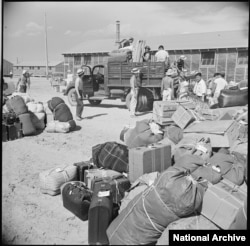After Japan’s surprise 1941 attack on Pearl Harbor brought the United States into World War II, President Franklin D. Roosevelt signed an executive order to summarily round up Japanese immigrants and Japanese Americans living along the West Coast.
Minidoka, in southern Idaho, was one of 10 main camps built to confine them. At its peak, it held nearly 10,000 people, most of whom were U.S. citizens.
Living witnesses to the forced relocation are growing fewer each year. Their descendants — and historians — want to preserve the memory and lessons from the unjust internment.
"We can see that those memories, those stories are slipping away," says Bif Brigman, who helps organize annual pilgrimages to Minidoka.
"We're losing the Issei, the first generation, and Nisei, the second generation of Japanese-Americans," he said. "We're afraid of losing those stories. That is one of the things that pushes us to do it annually, to keep doing it."
The first Minidoka Pilgrimage was held 13 years ago. Nearly 200 people journeyed to the site on the final weekend in June for the 2015 event.
One of them was Sam Kito Jr. He was five years old when his family was crammed into one room in a barrack block guarded by soldiers in a barren landscape of dusty sagebrush. Now 77, Kito says it was his daughter's idea to join the organized pilgrimage to the site.
"It was something I always heard about growing up, but it is not something anyone ever talked about for a while," 32-year-old Hope Kito recalled. "I don't think the magnitude of it was ever expressed. So it was worth coming with him."
"When you get new people or younger people involved, what happens is your mind starts thinking about what should have been better for your parents and your generations," Kito's father added. "Well, that's great. But you can't rewrite history. You live history the way the cards that were dealt to you and then make sure it doesn't happen again."
Mary Tanaka Abo, 75, was held at the camp when she was a child. In the midst of war hysteria, her family was "evacuated" — in the parlance of the day — from Juneau, Alaska. She came on the pilgrimage with her daughter and two grandchildren. This was her second trip back to the camp, and it brought back some uncomfortable memories.
"Being here made me ashamed of being Japanese when I was young,” she admitted.
The former internment camp is now managed by the National Park Service. Minidoka National Historic Site Superintendent Judy Geniac also feels the urgency to capture more voices of witnesses before they go silent.
"It would be incredible for us to figure out a way to have young people interviewing, whether it is their great-grandfather or it is their next door neighbor," she said. "We know that people from the camp went all over the United States after they left the camp."
Meanwhile, the physical remains of the Minidoka camp, which nearly disappeared, are being resurrected. A guard tower, barracks, mess hall and fire station have been rebuilt or restored in recent years. Geniac says a visitor center is in the works as are plans to recreate the central baseball field.












